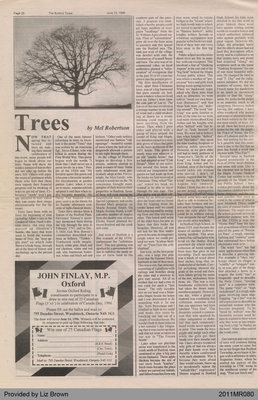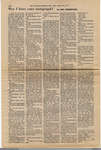Trees
by Mel Robertson
NOW THAT spring has returned and trees are making their annual celebration of this event, many people will begin to think about our trees. Some will decry the sodden messes of leaves they did not rake up before the snow fell. Others will enjoy the return of greenness while those who feel that these trees impede their financial progress will be thinking of ways to get rid of them. Cyberspace "nerds" won't pay any attention lo" trees" unless* they can create their image electronically for the Internet.
Trees have been with us from the beginning of time including Adam's tree in the Garden of Eden, Noah's shit-tam trees, the tree that mussed up Absalom's hairdo, the trees that were used to build the wooden horse of Troy, the "sour apple tree" on which John Brown's body hung, through all of the trees of history and mythology up to the present day.
One of the most famous references to trees in literature is the poem "Trees" that was written by an American Sgt, Joyce Kilmer, who was killed in action during the First World War. This poem begins with the words "I think that I shall never see a poem lovely as a tree." People of the 1920s and '30s loved to quote this poem and it became a favourite number for elocutionists at garden parties. Later, when it was set to music, soprano soloists adopted it and then when radio became popular, the company used it as the theme for its Sunday afternoon concerts of light classical music. Trees have always been a feature of the Burford Plain. Governor Simcoe's secretary mentioned them during his trip through the area in February 1793, and on Dec. 5, 1820, Col. Wm. Bowen's committee described our trees as follows: "Timber -Timbered with maple, beech, white pine, black and red chestnut, white and red oak, elm, basswood, butternut, white and black ash and hickory." Other early settlers mentioned our famous "oak openings" - beautiful stands of trees where the lack of undergrowth allowed a person to see right through them.
As the village of Burford began to develop a few streets, settlers started to plant avenues of trees. Some early inhabitants were particularly adept at this. For example, the Muir family, who owned a wood lot on the 7th concession, brought many samples of their trees to their properties in Burford. Some of these still exist among the Sprowl' s property and on the former Muir property on Maple Avenue South. On Maple Avenue North, a considerable number of maples from the double row of trees Elisha Stuart planted between Burford and the creek still exist.
Just west of Burford is a fine example of the 1930s' enthusiasm for "reforestation". This tree planting was sparked by a government desire to stabilize the sandy areas of farm land in the southern part of the province. A program was established whereby people could get large numbers of evergreen "seedlings" from the St. William Agricultural station. Plots of "reforestation" grew all over the farm areas in question and this spread into the Burford area. The land just west of the village was derelict with only the foundations of a small house and barn. The area was of no commercial value, so local authorities planted a "reforestation" of evergreens that in the past 50 or 60 years has grown into the present grove. My first recollection of trees, apart from Christmas trees, was of a big basswood that grew outside my bedroom window when we lived over my father's store (now the east part of Lee's). The leaves of this tree revolved in a strange manner in any kind of wind and a child awakening at dawn on a windy morning could imagine almost anything from the leaves. Then, when I grew older and played with a group of boys around the corner of King and Maple, our attention turned to a sizable grove of lilacs that grew on the lawn northwest of the 1851 house. This grove of sturdy trees was adjacent to an old "smoke house" that we had adopted as our "Club House". Most of our activities around this house involved our imagination and games we had made up from the books we had received at Christmas. Thus, when "Tarzan" reared his head, we wanted to be able to travel through the tree tops. This lilac grove was an ideal sub-
(less the lions) and we found that by leaping from the smoke house roof we could find a tree top road by swinging from one lilac tree to another. This lasted until some of the older boys became so heavy that they broke the branches. However, all was not lost for the lilac undergrowth became an imaginary jungle where we could pretend we were "fearless hunters" or "Turn-Turn the jolly elephant".
Just west, on the next property, was a large tree platform that the Hamner family had built in one of their trees. This was a very fine structure consisting of a platform with railings and benches along the sides and a stairway to give easy access. All of us wished that we had a tree in our yard for such a "tree house". The only sizeable tree on our land was a Manitoba Maple beside the house and I was determined to do something with it. So one day, Scott Bowerman and I climbed as high as we could and made tree seats by knocking one side out of a couple of wooden boxes. We would climb to these seats on a hot summer's day imagining that it was cooler up there and that we were aviators on our way to "The Frozen North".
Later when our playtime arena was transferred to the creek north of Burford, trees continued to play a big part in our fantasies. Thorn apple thickets became the site of our story book "battles", birch trees became the place where we carved our initials, and fallen branches from any tree were used to create bridges to the "Island" where we built brush huts in which we vowed to spend our lives as "fearless hunters", noble knights, solitary hermits or whatever occupation was popular in the books we read. Most of these huts and vows blew away in the first big wind.
Public school recollections about trees are few in number, with one exception. This involved a line of "Quaking Aspens" at the east end of the "big field" behind the Maple Avenue public school. This was where a number of "precocious" boys and girls went during warm spring recesses. When we backward types asked why these trees were such an attraction, we were told to "mind our own beeswax (business)" and that these kids were just "dallying around". The word "dallying" was quite familiar to kids of the time for we were read many stories about King Arthur and his knights who often "dallied" with "fair ladies" in "leafy bowers" of trees. We were led to believe that when knights "dallied" with "fair ladies", they spent the time reading Scripture or making noble speeches. However, as we grew older and had to study portions of Tennyson's "Idylls of the King", we found that apart from King Arthur and Sir Galahad, most of the knights would tackle any woman who moved. I don't, of course, suggest that the "dallying" among the Quacking Aspens was immoral. Rather, I think that due to the severe sexual segregation that existed at Burford Public School, some boys and girls liked to talk to someone besides their brothers and sisters and the Quaking Aspens were the only place they could do so without risking "one alongside the ear" from our overly-strict teachers.
In Burford High School, in about 1929, trees became the source of another eyebrow-raising incident. This arose when a fine old bachelor who lived on the Harley Road presented the school with a collection of wood samples from trees that grew in our township. Each specimen was a block of wood about four inches long that included a bit of the bark. Careful polishing showed the grain of the wood and there were labels giving the name of the tree, nicknames, locations, etc. This was a very handsome collection that had taken the donor many months to prepare. However, one day, when a group of students was examining this collection, someone noted that one specimen had been labelled "Piss Elm". This discovery created a commotion that was sparked by either indignation or disbelief that such commonly-heard words never appeared in print. This made the boys giggle and nudge each other while the girls put their hands over their mouths and ran. I have always wondered why girls of that era always put their hands over their mouths when confronted with such situations. Was it because they were afraid they would scream, throw up or accidentally repeat the "unladylike" expression? Horror reigned in Burford High School for kids were shocked to see this word in print. Indeed, there were laws against writing certain words on wooden fences and school authorities enforced rules against profanity with great vigour. However Mr. Judge, our principal, knew that the elderly donor had not used this description offensively and he explained to us that certain trees and plants had acquired "slang" descriptions such as the name "Stinking Benjamin" for one of our most beautiful trilliums. He changed the label to read "P. Elm" and the indignation subsided. He did not mention, of course, that the French name for dandelions is an insult to incontinent people or that the "slang" name for jacks-in-the-pulpit is an anatomic insult to all clergymen. However, before leaving this subject, I have often wondered why poems and songs of admiration have not been written to the elm, our most stately of trees. After all, there has been poetic praise for the oak, the maple, the Pines of Rome, the Cedars of Lebanon and the willow, but nothing for the elm. Is it possible that this omission is due to the fact that no poet has found a word that rhymes with "Piss Elm"?
Several trees in Burford figured prominently in the lives of 1920s' local children and some still exist. One is the chestnut tree in front of the Maple Avenue Medical Centre and another is on the grounds of the Maple Avenue Public School. I have written previously about the fascination children have for an another not used to stand in the centre of what is now Minshall Drive, were the sites of annual battles for chestnuts. The maple tree on the school grounds serves no particular purpose now, but in the 1920s it was the "Home Free" base for several generations of boys who played the game of "Prisoners Base", a rough, running, fighting and "rassling" game that entertained boys before electronics took over.
The word "tree" has had many applications other than to describe a growing tree. For example a "shoe tree" keeps shoes in shape; a "whiffle" or "whipple" tree, is, or was, part of the things that attached a horse to a wagon; the word "tree" is frequently used to describe the Holy Cross; "treeing nails" is a carpentry term. The game "tree" or "high cockalorum" is a rough male game involving mass leapfrogging, "up a tree" was an old expression to describe an unmarried woman who has become pregnant. To be "treed by wolves" was the favourite excuse used by men to explain to their wives why they were so late returning from a trip "to Harley on the bum". Many other uses of the word exist.
Our interest and enjoyment of trees will continue during the many years to come, but let us not forget that Burford Township, as we know it, began with a reference to trees; Augustus Jones, when he started his survey of the township in 1798, wrote in the northwest corner of his map, "Post one birch tree".



